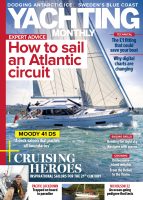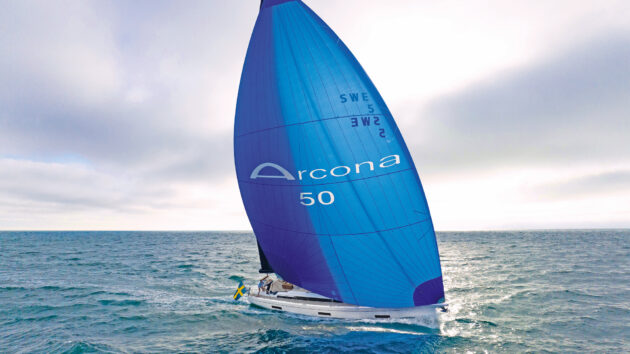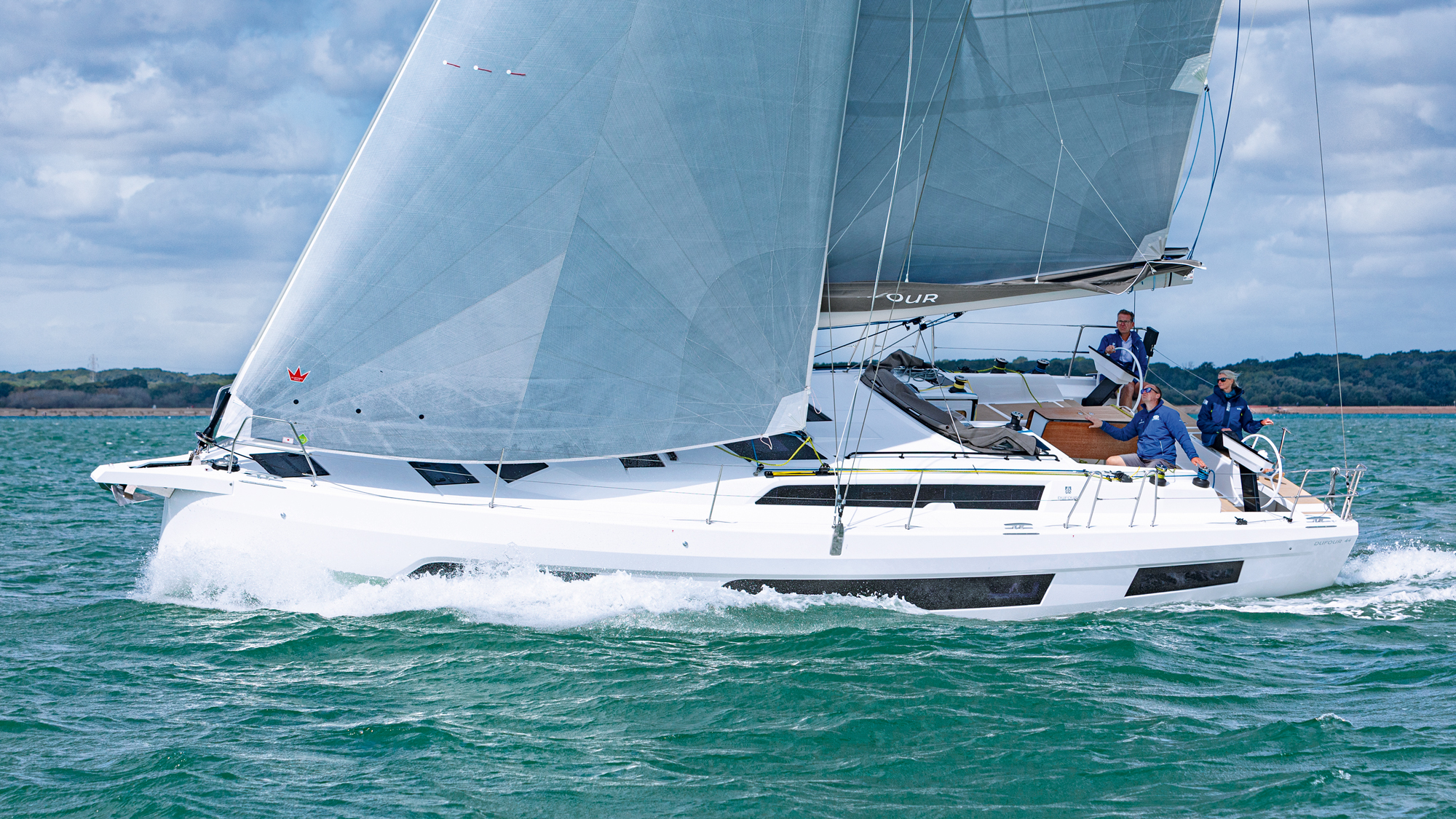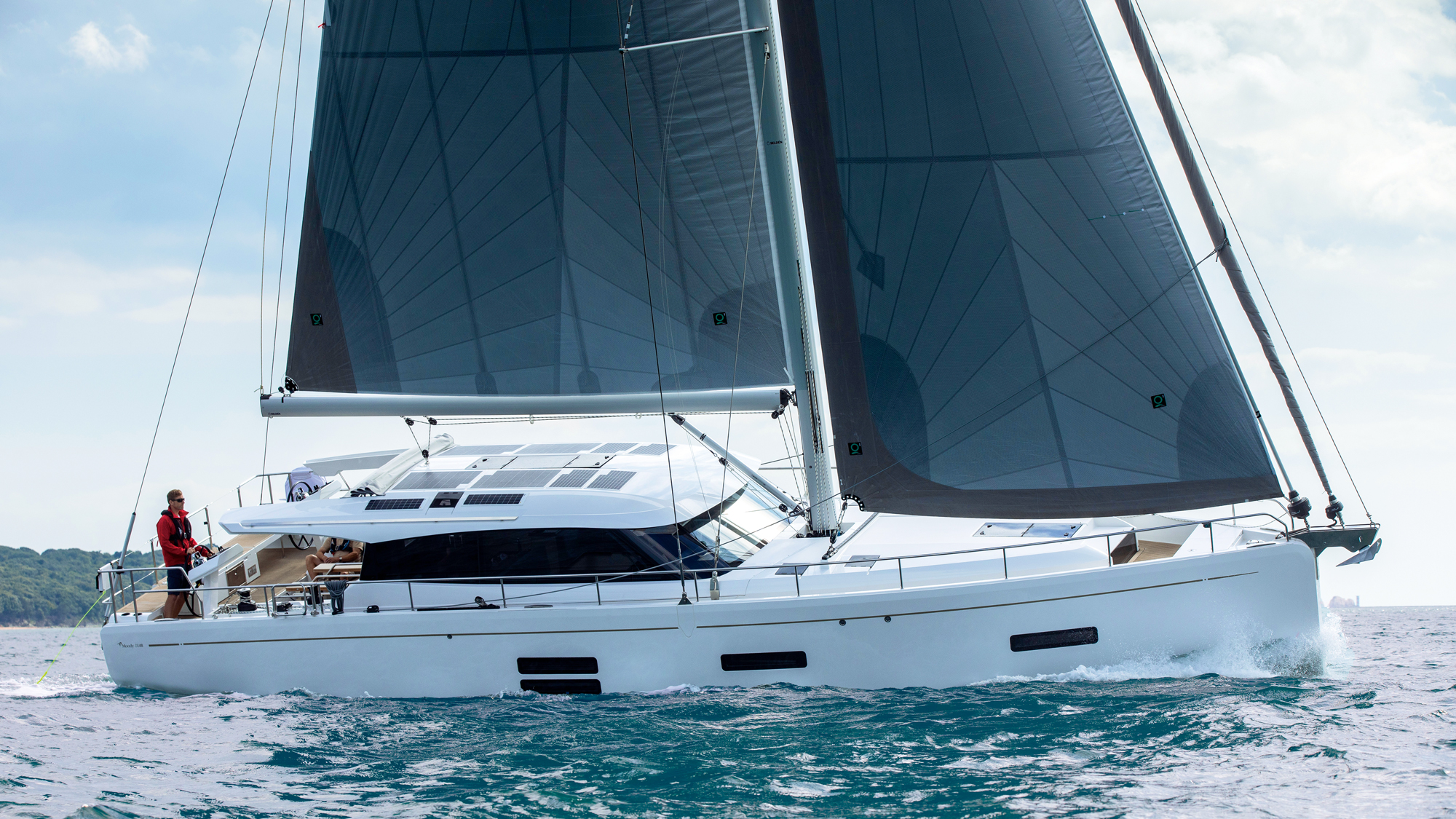The new flagship Arcona 50 from the Swedish yard represents a new era and a bold new direction. Theo Stocker went to find out whether there is still a family resemblance to her smaller siblings
Arcona 50 review: Does the new Arcona flagship impress?
Does a metre really make that much difference when it comes to boat length? It may be one small step up in size, but it represents a giant leap for the normally understated Swedish yard Arcona. Take a look at their stunning new flagship, the Arcona 50, and you’ll see how different this boat is to the rest of their fleet.
Stefan Qviberg, the yard’s resident designer, passed away in 2018 having drawn every Arcona from 1982 onwards. The new designer had some big boots to fill. Conveniently, the design duo of Niels Jeppesen and Ariadna Pons had recently stepped away from X-Yachts to establish their own design practice.
The potential accusation that the Arcona 50 looks more like an X-Yacht is therefore not entirely unfounded, though Arcona would respond that it looks like an Arcona drawn in the style of Jeppesen & Pons, rather than an imitation of any other yard.
The fact is, however, that a wide, full stern that is balanced by full bow sections, pronounced hull chines and twin rudders represents a departure for the Swedish yard from its trademark fast, sleek and sharp-bowed coastal cruisers.
It represents not only an incorporation of the recent advances in design thinking, but also the entry into the highly competitive luxury cruiser market. She’ll stand toe-to-toe with other yachts around the 50ft, £1m mark, including the Solaris 50, X-Yachts X49, or Swan 48 as well as boats from Grand Soleil and Oyster.

The Arcona 50 represents a new era and a bold new direction. Photo: Paul Wyeth
Distinctive DNA
That being so, I was keen to find out how much of the distinctive Arcona DNA has survived this evolution.
I was joined for the test sail by the boat’s designer, Ariadna Pons, and as she enthused about the boat, it became clear that this is a boat that is set apart by understated but key details. The Arcona 50 may do similar things to other boats, she just aims to do them better.
Vacuum-infused, foam-cored bulkheads and locker fronts with bespoke-machined aluminium catches save seemingly insignificant grams, but cumulatively these details shave a whopping 10% off the boat’s weight using standard methods. 5% of that weight has been put back into the boat, but at the bottom of the massive 2.95m keel.
This keel, a fin of Swedish cast iron with a lead bulb, was the recipient of some science magic. Structurally, it is bolted straight into the hull’s galvanised steel matrix, itself bolted to the hull’s frames and stringers, making it far stiffer than a GRP matrix. The keel root is located in a recess in the hull, giving a more watertight bond, but also ensuring perfect alignment of the keel every time.
Article continues below…
Dufour 44 review: Roomy and competitively-priced cruiser
There are many questions to ask when assessing a boat, whether as a journalist or a potential purchaser, but perhaps…
Moody DS48 review: We sail this new yacht across the English Channel to see if she has what it takes
High topsides, muscular bow sections and a formidable deck house make the Moody DS48 an imposing sight, even standing alongside…
The lead bulb is formed around and bolted through a steel H-beam to give structural integrity. The fin shape tapers downwards, taking account of the increasing density of water at depth, but the leading and trailing edges, and the keel’s width, all curve convexly out towards the keel’s midpoint to get water travelling across it at the same speed for its whole length, thereby reducing turbulence and drag.
So too with the hull lines. The inverse knuckle half way up the bow, and the way a bevel in the topsides flows all the way aft to the stern chines, may be a purely aesthetic nod to racing machines like the IMOCAs and TP52s, but the moulded carbon bowsprit being set a few inches below deck height adds critical length to the Code Zero and gennaker luff lengths.
Finally, a flatter run in the hull towards the stern than you would usually find on a boat of this displacement helps the wake separate smoothly from the transom. Whatever the outward appearance, this is a boat that is really made to sail.

Though spacious and not particularly deep, the cockpit layout creates a feeling of security. Photo: Paul Wyeth
Power play
With the last of the summer warmth, we headed out to try our luck on a meteorologically confused day. The northerly wind inevitably brought a tricky breeze, fluctuating between 5 knots and 25 knots and shifting all over the place. These weren’t necessarily easy sailing conditions, but they promised plenty to get our teeth into, at least in parts.
Having slipped lines, getting out of a tight marina berth was made easier by the retractable bow and stern thrusters. With the 100hp Yanmar ticking along at 2,000rpm we made over 7.1 knots down the river, while 2,500rpm gave us 8.8 knots and max chat at 3,000rpm a blistering 10.1 knots.

The helm is light and precise. Photo: Paul Wyeth
The test Arcona 50 was fitted with a GRP furling boom from Mainfurl. With topping lift and kicker set to marks, the powered winches aft made light work of the hoist, while the Code Zero, set off the inner tack point on the carbon sprit, had us ghosting out to seaward in just a handful of knots.
Clearing Calshot, the breeze filled in to the lower end of Force 4 as we headed out toward Portsmouth and our speed jumped to just over 9 knots with just the slightest heel onto the boat’s broad hull chines.
Power on tap
Turning back upwind we added some halyard and backstay tension, using the powered winches to bring the main’s full power to bear. Having set leech twist, a push of a button moves the mainsheet traveller up or down the recessed track as required; captive Harken winches can shift the car across the boat in eight seconds, making it a useful means of dumping power in gusts. Speeds of 7-7.5 knots at 28-29º to the apparent wind of 16-17 knots were easily reached and some tweaking would probably give a little more.

In boom furling keeps the sail very neat, but it needs to be fully depowered to reef with the boom at exactly the right angle. Photo: Paul Wyeth
Clearly, the loads on a 14-tonne, 50ft yacht are high, and a generous sailplan with laminate sails means there’s plenty of power in the rig. The electric winches, twin hydraulic backstay cylinders and electric traveller all help tame the forces at work and make this a boat that’s possible to sail shorthanded.
The only time the Arcona 50 got anywhere close to rounding up was when we were caught off-guard by a gust at the top end of Force 6, with full sail sheeted in hard. A quick push of the traveller button dropped the main down the track to rebalance the boat and restore rudder grip, while slightly flatter sails and a little more twist had the boat quickly back on track despite the conditions.
The feel through the large carbon wheels is reassuringly taut, precise and light – possibly even a little too light. I’d like a smidgen more feedback to tell me when I’ve got the boat balanced and when things are getting loaded up. This may just be a case of adjusting the toe-in angle of the rudders, or perhaps the rudder profiles, but neither is impossible.

A Code Zero adds power on reaching and off-wind courses. An integrated tack line for the asymmetric is led aft through the bulwarks. Photo: Paul Wyeth
Before we headed in, there was time for one last blast west out into the Solent, this time under the whopping 222m2 asymmetric. We topped out at 10.3 knots, suggesting this is just about maximum hull speed. With a following sea, this hull has the potential to take off and surf if you want her to, though that’s not what the Arcona 50 is really about.
Cockpit control
The Arcona 50 deck layout is configured for the shorthanded sailor – realistically she’s easily handled by two if one is helming, but judicious use of the autopilot and powered winches would allow her to be sailed solo, especially if you added buttons to control winches on both sides from either helm.

All the controls just where you need them, though the buttons for furling would be better on top of the console. Photo: Paul Wyeth
The winch controls, engine controls, radio and thruster controls all fall easily to hand on the pedestals, alongside the chartplotters. Only the furling genoa buttons required reaching through the wheel, but these could easily be moved to the top of the panel. The winches and clutches are located forward of the helm; the aft one can easily be winched manually from the helm, and the forward one is powered anyway.
Off the wind, the mainsheet falls cross the leeward winches, so worth checking when gybing. Cockpit coamings are taken all the way aft to the outboard helm seats. If you want folding helm seats aft, these can be added.
With 4.6m of beam to play with, the Arcona 50 is the yard’s widest ever boat, and as such, there’s enough space for split cockpit tables keeping a clear central walkway, while providing L-shaped seats and decent-height coaming for relaxing as well as good bracing, making the cockpit more secure than the low coachroof and relatively high cockpit sole might initially suggest. Fold up the sprayhood from its under-deck stowage and you’re properly sheltered.

Integral washboards slide down into the bulkhead. Photo: Paul Wyeth
Game-changing details
Little details have been carefully thought out. Rope bins in the coamings under the winches catch the rope tails, and the aft end of the coamings lift up to reveal a two-bottle gas locker on one side and shore-power stowage under the other.
Fuel tank breather vents are concealed inside the pushpit railings ventilated with small holes, making them all but invisible. The only thing missing was stowage in the tables to put bits and bobs like bottles and binoculars.
There’s a well under the cockpit sole for a liferaft. The dinghy garage, revealed when the bathing platform is electrically lowered, is a vast space with room for an inflated 2.7m dinghy. Forward of the helm you can opt for a fixed mainsheet block recessed under the sole, or the recessed electric traveller as on the test boat.

Clever light, natural and artificial, neat details and a superb finish make the saloon comfortable, welcoming and spacious. Photo: Paul Wyeth
Given this boat’s performance credentials, I’d be surprised if any owners didn’t take the traveller. Luckily the recess can be accessed via the dinghy garage, which was useful for retrieving my dropped pen at the end of the test.
On deck, the sidedecks are wide and unobstructed, with good deep moulded bulkwarks, through which the spinnaker tack line is cleverly led aft. The coachroof grab handles take you to the shrouds and mast, where there are tracks for the overlapping genoa, as well as for a self-tacking jib.
Flush hatches and a below-deck electric genoa furler keep the lines clean, while the carbon bowsprit is moulded in two pieces for a smarter finish. The bow locker has more than enough space to drop at least two offwind sails down into it, as well as fenders and other kit.

Ample stowage and options for freezer and dishwasher make this a practical galley. Photo: Paul Wyeth
Another significant marginal gain is that the anchor chain is stowed in its own well at the aft end of this locker, rather than forward, bringing it over 1m away from the bow – a significant distance for such a large weight – which helps reduce pitching, as well as leaving more space for stowage.
A refined world
Head below and you enter a refined world of subtle lighting, beautifully crafted joinery and fabric-clad hull linings. My eye was immediately caught by the forward saloon bulkhead, which is dedicated to book shelving and a recessed TV housing.

There’s no shortage of space or stowage in the forward cabin either, with generous lockers
flanking the hull and deep drawers under the bed. Photo: Paul Wyeth
The effect, as you sit around the C-shaped seating to port, is of being in a living room at home. Overhead lockers add extra stowage to the under-settee lockers, so there’s ample space for kit, in part thanks to the water and diesel tanks being midships under the cabin sole, which helps keep weight low and central.
To starboard, there’s a straight settee that will serve well as a sea berth, ahead of a full-sized chart table, which on this boat faces outboard with a swing-out stool, though you can have a forward-facing chart table if you prefer. There’s stowage for leisure folio charts in the shallow table, and a useful recess at the back of the table to stow the usual detritus of life on board.

A forward-facing chart table is an option but this boat had an outboard-facing one. Photo: Paul Wyeth
Show-stopping galley
Most impressive though, perhaps, is the galley to port at the bottom of the companionway. Two sets of drawers, two pan lockers, a 90L top opening fridge, three-burner gas oven (electric/induction an option), lockers behind and above the work surface, and even an upright locker that houses the obligatory Nespresso machine – you need good coffee at sea – makes this a fully functioning kitchen.
The separate little sink to keep dishcloths in and the fiddle to stop surface water running across and down into the fridge are pleasing details. There’s even space for a drawer dishwasher under the sink, or you can opt for a front-opening fridge here, and even a third fridge in place of the outboard set of drawers if you really want.
Opposite the galley is the main heads, including separate shower compartment, and space for a hanging locker or an optional washing machine.

Both aft cabins include twin beds that can be joined or separated by an infill. Photo: Paul Wyeth
Moving around when at sea is made easier by a good number of handholds dotted around, as well as the wooden grabrail along the carlins under the corner of the deck edge. The only one I’d add, and this is an option, is a stainless steel overhead rail that runs all the way around the deckhead liner to ensure there’s always somewhere to hold onto.
The aft cabins both offer more than king-size wide berths, both of which can be split into singles to make twin cabins with the removal of an insert, giving flexibility to sleeping arrangements depending on who you have aboard.

The bowsprit is made of two moulded parts to hide an unsightly underside. Photo: Paul Wyeth
Stowage in upright and overhead lockers, as well as under the berths is good, with lighting in all the right places. There’s also access to the sides of the engine compartment and midships machinery space abaft of this – the larger 100hp Yanmar diesel and optional generator make the machine space rather snug, but it’s all well laid-out and easily accessible.
The real coup de grâce though is the forward owners cabin. There’s over 190cm of headroom, with a midships kingsize bed, a generous heads with lots of lockers and a separate shower compartment. Lift up the bed, supported with gas struts, and there are two large stowage bins, and two more deep drawers below those. The forward space under the berth is given over to the bowthruster.

A wide stern and flat aft sections gives the 50 good speed potential off the wind. Photo: Paul Wyeth
Arcona 50 specifications
LOA: 15.80m/51ft 10in
Hull length: 14.99m/49ft 2in
LWL: 13.98m/45ft 10in
Beam: 4.60m/15ft 1in
Draught (standard): 2.95m/9ft 8in
Draught (medium): 2.5m/8ft 2in
Draught (shallow): 2.2m/7ft 3in
Displacement: 13,900kg/30,644lb
Ballast: 4,600kg/10,141lb
Sail area: 142m2/1,528 sq ft (151m²/1,625 sq ft)
Bal/disp ratio: 33%
Disp/length: 142
SA/D Ratio: 25
Engine: 110hp (80hp standard)
Transmission: Saildrive
Water: 375L
Fuel: 385L
RCD: Category A
Designer: Jeppesen & Pons
Builder: Arcona
Enjoyed reading this?
A subscription to Yachting Monthly magazine costs around 40% less than the cover price, so you can save money compared to buying single issues.
Print and digital editions are available through Magazines Direct – where you can also find the latest deals.
YM is packed with information to help you get the most from your time on the water.
-
-
- Take your seamanship to the next level with tips, advice and skills from our experts
- Impartial in-depth reviews of the latest yachts and equipment
- Cruising guides to help you reach those dream destinations
-
Follow us on Facebook, Twitter and Instagram.






